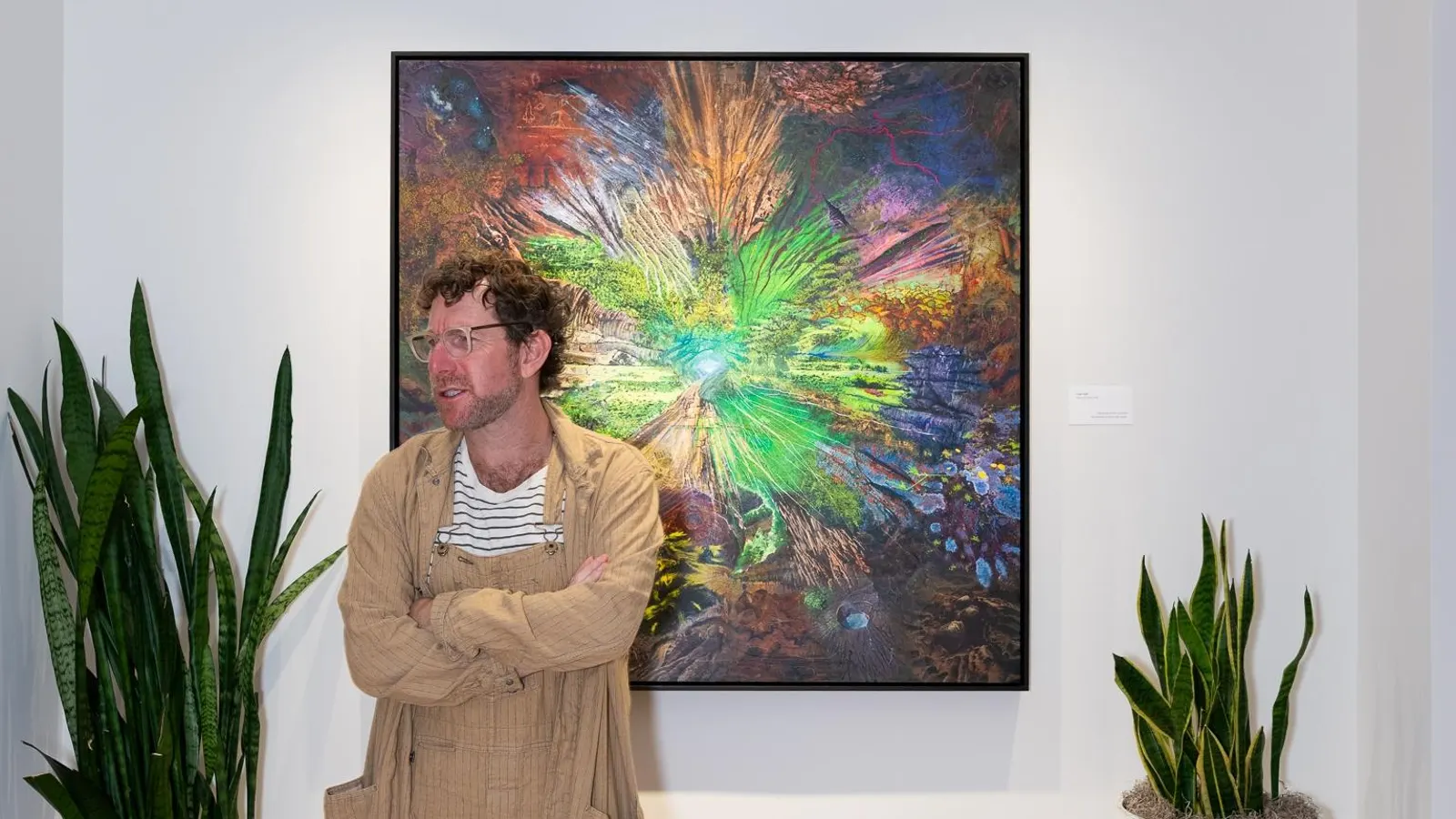Illuminated Gaze: How Lutron Draws Us Deeper Into Dustin Yellin’s Complex, Immersive Visual Narratives
By Contributor,Natasha Gural
Copyright forbes

Dustin Yellin in front of Werner’s Crater (2025) at Lutron in New York
RYAN TISCARENO
Under a purple light, the viewer is drawn into the center of the canvas, as if there’s a pathway into a portal to another dimension. Red lighting in the upper right is magnified, along with lines emanating from the center. Explosions of green that feature prominently under white light absorb red and blue under the purple light, and blues take on more nuanced shades.The effect is an otherworldly terrestrial landscape that hints at underwater environments like nearly-violet bioluminescence.
Best known for his monumental laminated glass sculptures embedded with layered imagery and paint to create intricate three-dimensional collages, Dustin Yellin’s Werner’s Crater (2025), a collage and acrylic on canvas, unveils a new perspective into his multidisciplinary practice.
The Brooklyn-based contemporary artist, who delves into the complex interrelationships within the nuances of nature, technology, and the human condition, included the impression of a light bulb in the upper-middle right of Werner’s Crater, perhaps as a pithy nod to his collaboration with Lutron. The complexities of Yellin’s singular oeuvre illuminate how an innovative design and technology-centered company may enhance the viewer’s experience by managing natural and electric light.
Dustin Yellin Werner’s Crater (2025) on view under purple lighting at Lutron in New York
RYAN TISCARENO
Yellin (born 1975, California) lives and works in Brooklyn, exploring painting, sculpture, animation, and institutional collaboration. An experimentation with Lutron underscores the value of carefully curated and thoughtful lighting by navigating the viewer’s eye, mind, and feelings deeper into his immersive works. As founder and director of Pioneer Works, (PW), an artist and scientist-led nonprofit cultural center in Red Hook, Brooklyn, embracing Lutron’s cutting-edge lighting technology and solutions amplifies Yellin’s celebration of the visual and performing arts, technology, music, and science.
MORE FOR YOU
Lutron encountered Yellin during the COVID-19 pandemic, when he inquired about how Ketra (a manufacturer of high-end, human-centric lighting systems, which was acquired by Lutron) lighting was being used to illuminate one of his life-sized Psychogeographies sculptures. The series borrows from and advances the term psychogeography, coined in 1955 by French Marxist theorist, writer, filmmaker, and revolutionary Guy Debord to describe the effect that geographical environments have on the emotions and behavior of individuals. Debord (193-1994) co-founded the Situationist International (SI) – a radical and influential group of avant-garde artists, intellectuals, and political theorists active in Europe between 1957 and 1972. Also known for his influential 1967 book, The Society of the Spectacle, Debord critiqued capitalism and modern life, arguing that genuine experience had been replaced by mediated representation, a theory which seems even more vital today.
“I think we’re moving into a very strange time with technology. And I think that things are becoming more and more specialized and more and more siloed, which I think is getting us farther and farther away from truth. We really need to build a new house of being where all of these different ideas can come together and influence each other,” Yellin told me in 2023, when his phantasmagorical allegory, The Politics of Eternity (2019), made its debut at Liberty Science Center in Jersey City, N.J.
Installation view of Prisms of Light, An installation of Art & Light Lutron x Dustin Yellin, transforms under Lutron lighting
Ryan Tiscereno @theRyanTiscereno
Yellin’s intriguing, sometimes unsettling, humanoid figures are created using layered images that act as symbolic, dream-like cartographies, which can be more intently appreciated by gazing at them under an array of lights. The viewer’s mood shifts with the lighting, expanding the conversation as various lights draw the gaze closer to different details, amplifying the dialogue with Yellin’s visual narratives.
“I got in touch with him, and we went into his studio to explore what we could potentially do to retrofit the lights in his space. (His studio) probably has triple-height ceilings, big skylights. He wanted light that would really emulate natural daylight, because that’s the light that he was working in throughout the course of the day, and he wanted his team who work in the evening to be able to have that capacity to really structure the lighting accordingly, doing that kind of discovery of what light can do,” explained Cecilia Ramos, Senior Director of Architectural Markets at Lutron, during an intimate walkthrough of Prisms of Light: Beyond the Surface, which was on view at Lutron’s New York showroom this month. “I think it made him really think differently about light and his art and how it all interacts, because, of course, these are very reflective, refractive plate pieces and are expressed differently through art.”
Installation view of Prisms of Light, An installation of Art & Light Lutron x Dustin Yellin
Martyna Szczesna @martynaszcz.jpg
Ramos demonstrated how Yellin’s works transform beyond typical gallery lighting. His studio team appreciates how subtle soft pink/white crystal lighting neutralizes the green of the glass. Ramos revealed how the sculptures come to life, pulsating with emotion, as light sweeps through a cycle to mimic the day-to-night transition, from soft dawn gold, to midday clarity, to the dusk’s warmth, and into the retreat of night. Drenched in highly vibrant light for heightened illumination, each collage detail shimmers and the smallest symbols and textures are amplified to enhance the visual narrative. The journey evolves, when the sculpture is backlit with a cool white front light to showcase the illusion that the figure and its environment are immersed under water.
“In our initial explorations of materiality with (Yellin), we started playing with adding a slight pink pigment into the light to neutralize a bit of that green glass. Then there was this kind of discussion, an exploration of how you can use light to really bring up saturation and different colors and make things kind of push and pull,” Ramos recalled.
Installation view of Prisms of Light, An installation of Art & Light Lutron x Dustin Yellin
Martyna Szczesna @martynaszcz.jpg
Yellin’s meticulous creative process for creating three-dimensional collage, which he calls “frozen cinema,” involves layering thousands of individually cut images, paint, and other elements between sheets of laminated glass. He begins by gathering and cataloging those images in a “taxonomy of drawers.” Yellin and his team painstakingly apply the individual cut-out images and paint onto multiple panes of glass, using a technique he calls a “window sandwich.” Each composition is built from the background to the foreground to create the illusion of a three-dimensional figure or scene encased within the glass block. Such precision requires careful examination throughout the process, under ideal lighting.
Lighting plays a vital role in the creation and presentation of all artworks. Throughout art history, light has functioned as a foundational tool for creating form, volume, and perspective through techniques such as chiaroscuro and sfumato. For the viewer, lighting helps to convey mood, emotion, and symbolic meaning, elevating the experience and fostering empathy through a shared appreciation for visual art.
While Yellin’s work is exceptional under any light, experiencing the range of emotions and emergence of myriad details that comes with lighting transitions underscores the need for expertise.
“In the right light, at the right time, everything is extraordinary.” _ Aaron Rose, film director, artist, exhibition curator, and writer, best known as the co-director of Beautiful Losers, a film featuring artists such as Barry McGee, Margaret Kilgallen, Steven “Espo” Powers, Chris Johanson, Harmony Korine and Shepard Fairey.
Moreover, in a testament to the Lutron-Yellin collaboration, great art demands great lighting.
Editorial StandardsReprints & Permissions



